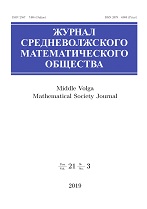|
Mathematical modeling and computer science
Numerical simulation of turbulent flow in a channel with a bend
T. Yu. Balabina, Yu. N. Deryugin, E. A. Kudryashov
RFNC- VNIIEF (Sarov, Russia)
Abstract:
This article presents the results of a numerical study of the turbulent flows’ structure in the construction elements under consideration, for which grid models are constructed that correspond to turbulence modeling approaches. More specifically, these approaches invoke Reynolds Averaged Navier-Stokes equations (RANS), equations closed using one or another semi-empirical turbulence model, as well as vortex–resolving approach, in particular, the method of large vortices modeling (Large Eddy Simulation – LES). The flow calculations were performed both in stationary and non-stationary settings using the LOGOS complex on a parallel supercomputer. From the analysis of the results obtained, it is concluded that the averaged flow parameters found within a non-stationary formulation using a zone RANS-LES transition in the turbulence model qualitatively and quantitatively better coincide with experimental data than the results of stationary calculations based on the use of the RANS approach. Verification of the numerical technique was carried out by experimental data obtained on the FT-18 aerodynamic stand on the basis of Nizhny Novgorod State Technical university named after R.E. Alekseev. A quantitative criterion for the effect of structural changes on the uniformity of the flow is the vorticity level.
Keywords:
numerical modeling, gas turbulent flow structure, Navier-Stokes equations, Reynolds averaging, grid models
Received: 26.06.2024
Accepted: 27.11.2024
Citation:
T. Yu. Balabina, Yu. N. Deryugin, E. A. Kudryashov, “Numerical simulation of turbulent flow in a channel with a bend”, Zhurnal SVMO, 26:4 (2024), 424–441
Linking options:
https://www.mathnet.ru/eng/svmo897 https://www.mathnet.ru/eng/svmo/v26/i4/p424
|

| Statistics & downloads: |
| Abstract page: | 40 | | Full-text PDF : | 8 | | References: | 7 |
|




 Contact us:
Contact us: Terms of Use
Terms of Use
 Registration to the website
Registration to the website Logotypes
Logotypes









 Citation in format
Citation in format 